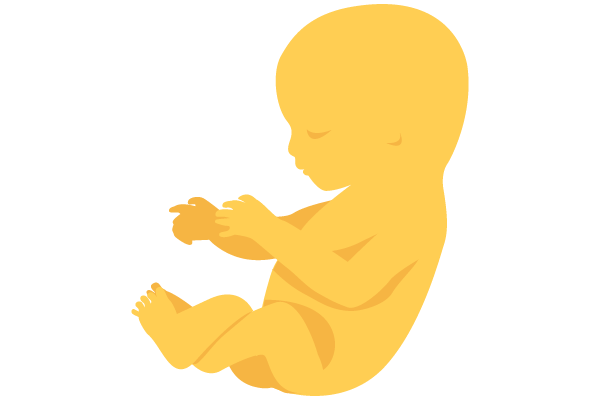
16 weeks pregnant
For information about weeks 16 to 19 of a twin or multiple pregnancy, tap here.
One very exciting development on the horizon? You’ll notice Baby’s first movements soon — sometimes called the "quickening" — as they grow stronger and more coordinated each day!
How’s Baby?
If the reality of your pregnancy doesn’t quite feel real yet, it may after your little one starts kick, kick, kicking away. If this is your first pregnancy, you may not feel Baby kick for another few weeks, so if you don’t feel that “quickening” just yet, don’t worry. Those kicks will be coming soon enough! At just over 7 inches long, and weighing 5.2 ounces, your little kicking bundle of joy just keeps getting bigger and bigger. The ears that have been moving to the sides of Baby’s head over the last few weeks are now developed enough that your little one can probably hear all the sounds that you do, which is yet another way that they are preparing for life after their big arrival. And even though your baby’s eyelids are still sealed, they have also matured and developed enough that can detect light through your belly.
What's new with you?
Waiting for that first kick can sometimes cause a bit of anxiety, and it’s common to mistakenly identify another internal movement as Baby. So don’t worry if you experience this confusion. Even if you’ve been pregnant before, all pregnancies are different, and what you might have been certain was a kick or gas before, can still catch you off-guard the second time around. Those first movements can feel like a range of things, from a small flutter like butterflies, to gas, to popcorn popping. Soon enough you’ll know for sure that Baby’s kicks are kicks!
Some other changes you might notice this week? The increased blood flow that’s helping with healthy circulation in your growing body and helping your body get ready to breastfeed is also going to keep contributing to increased vaginal discharge and nasal congestion. You might also notice constipation and the appearance of varicose veins. Your back may start to hurt soon as well, as that growing baby bump is changing your center of gravity and straining your back forward. There are a few simple ways to alleviate back pain: wear supportive shoes, keep good posture, and engage in pregnancy-safe exercises to support your core muscles. Using pillows, or even getting a pregnancy pillow, to use for support as you sleep on your side may also help relieve some of this discomfort. And you should speak to your healthcare provider about any major discomfort — or even if you just have questions about what sort of discomfort is normal — as they may be able to make further recommendations to help you find some relief.
This is also the time for some medical tests that can help determine whether all is going smoothly with Baby’s development. These include ultrasounds and multiple marker tests (MMT) of your blood. If any of those screenings raise red flags, an amniocentesis procedure might be the next step. Not every pregnant individual needs to get this procedure (which is an invasive procedure that involves a low risk of miscarriage), but some healthcare providers recommend it to folks of advanced maternal age, folks with other risk factors, or folks whose initial screening tests raised concerns. Many folks find it helpful and reassuring to find out as much as they can about their baby’s unique health and development, and you can speak with your provider about what tests would be best for you.
Reviewed by the Ovia Health Clinical Team
Read more
Sources
- Sir John Dewhurst. Dewhurst's Textbook of Obstetrics and Gynaecology. 8th ed. Keith Edmonds. John Wiley and Sons Ltd, 2012. Print.
- Mayo Clinic Staff. "Fetal development: The 2nd trimester." Mayo Clinic. Mayo Clinic. June 30, 2020. https://www.mayoclinic.org/healthy-lifestyle/pregnancy-week-by-week/in-depth/fetal-development/art-20046151.
- Mayo Clinic Staff. "Prenatal testing: is it right for you?" Mayo Clinic. Mayo Clinic, August 25, 2020. https://www.mayoclinic.org/healthy-lifestyle/pregnancy-week-by-week/in-depth/prenatal-testing/art-20045177.
- Mark A Curran, M.D. “Fetal Development.” Perinatology.com. Perinatology.com. March 31, 2019. https://www.perinatology.com/Reference/Fetal%20development.htm#1.




